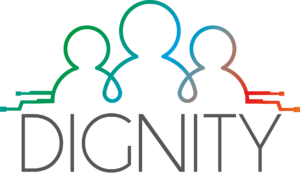Scenario Building in a nutshell:
Scenarios are the most important methodological tool in futures research, and “are of a crucial practical importance for public policy, management and strategic thinking in general” (Aligica, 2005, p. 815). The scenario building technique aims to analyse possible developments in the future and to present them coherently. One or more alternative future situations are outlined, and often the paths that lead to them are also described. In this respect, scenarios serve to show possible options for future developments. Scenarios help overcome thinking limitations by developing multiple futures. Scenario processes create possible, probable, and preferable visions of the future. They are focused on what might yet be. Scenario development increases the ability of organizations and institutions to deal with their uncertain environments.
The deliverable aims to explain the scenario building approach in the context of DIGNITY. The explanation of the procedure is presented in two steps. In the beginning, the scenario method is explained in general and in an ideal-typical way. This step is contextualized by explanations about foresight and planning. In the second step, the general procedure of scenario building is operationalized and developed in the form of concrete guidelines. In this way, the users in the pilot cases will be enabled to carry out the scenario processes on their own and with the professional support of the IZT. The guidelines will be used as a basis for guidance in the four DIGNITY pilots. According to the information and feedback collected from the pilot cities and regions, the methodology will be fine-tuned and standardized for exploitation in task 2.3.
The scenario building process consists of three main steps:
1) an assessment of the local/regional situation;
2) the development of scenario’s; and
3) the development of programs, plans, and options for actions.
The most important goal of the document is to raise awareness for the specific way of scenario thinking. This requires openness, contingency consciousness, and complexity competence. Another goal is to adapt the method to the problems and challenges in the pilots. The actors in the cities and regions have the task of developing strategies for digitally inclusive mobility systems. The scenario method should help them to do so.
The Inclusive Design Wheel in a nutshell:
The Inclusive Design Wheel offers a structured process for generating solutions to challenges, with an emphasis on creating solutions that are usable by as many people as reasonably possible. This approach can be applied to specific problems affecting a particular user group, all the way up to addressing widespread societal challenges. It is a flexible, managed creative design process, which provides for explicit design iteration and addresses the need for measurement of success.
There are three principal phases, Explore, Create and Evaluate, which are mediated by activities coordinated in the Manage phase. The approach and activities in each phase are outlined briefly within this document to provide easy to refer to guidance for project teams aiming to design an inclusive solution.
The process starts in the Manage phase with the Review progress & agree next steps activity. This facilitates the fledgling team to think about the goals of the project and then to identify and start putting together the team and stakeholders who may be able to support the project. Other activities in the Manage phase support team communication and focus and develop the arguments for putting the solution into practice.
Once the project team is sufficiently formed, they carry out a selection of activities in the Explore phase to help them understand the problem(s) that they are going to address. These include understanding who the relevant stakeholders are, and examining available information to help them understand the users’ needs. Based on this, the team then identifies the goals of the project in terms of the needs to be addressed and potential key performance indicators for the project.
In the Create phase, the emphasis is on finding as many potential solutions to the needs as possible. The bigger the potential solution pool the team can choose from, the better the final solution is likely to be. As a part of this process, examining the results of the scenario-building process from Dignity’s deliverable D2.3 can help to contextualise and understand the problem in more detail, and can inspire ideation. There are also various methods to stimulate the generation of ideas and concepts. These ideas can then be developed into more cohesive concepts which can be expressed in storyboards and prototypes for team and wider communication.
The Evaluate phase captures the activities that need to take place to ensure that the project is on track, and will deliver a solution that solves the needs identified in the Explore phase. An activity prompts the team to check that the project is aligning with the requirements of the Key Performance Indicators (KPIs) and that the KPIs still reflect the goal of the project. The Identify improvements activity reminds the team to seek opportunities for improvement in the solution, following the evaluation activities. The remaining activities focus on gaining useful guidance and information from users and stakeholders, experts and through exclusion assessment.
Specific guidance for the Dignity pilots to appropriately adopt and adapt the process for their needs is contained in this document, although further help and guidance is available from the authors and at www.inclusivedesigntoolkit.com.

